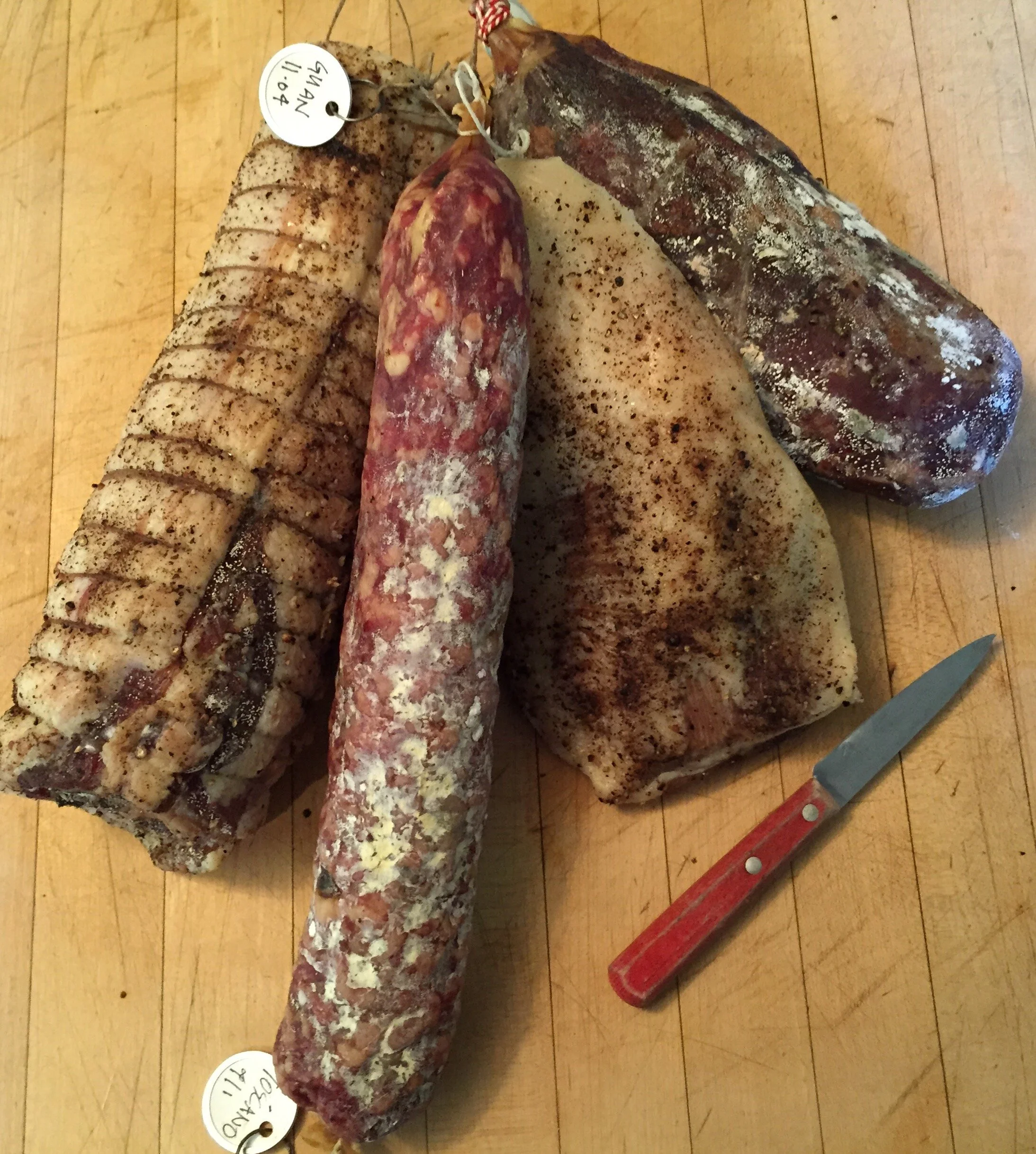Folks ask me all kinds of questions about salumi: How’s it made? How long will it last? Will it go bad? What’s the best way to store it? Below is a brief discussion relating to those questions.
Pancetta arrolata, Salami toscano, Guanciale, Coppa, Richmond, CA, 2015
salumi: its care and and storage
DRY-CURED MEATS: SALAMI, COPPA, LONZA, PROSCIUTTO, ETC.
Salumi and charcuterie – Italian and French dry cured meats – are living foods that have their own unique microbiology, like cheeses. They need air to breathe to maintain their quality. Though air causes moisture loss over time, a certain amount of air exchange or transactions necessary to prevent stickiness and unwanted, dark-colored mold. Ironically, in modern times – the age of refrigeration – there have been no new effective techniques or methods for storing cured meats. Plastic, the “miracle” material of the 20th Century, is the death of salumi, as it cuts off all contact with the outside world that the meats might have. Avoid wrapping salami in plastic if you can. Unfortunately, the USDA promotes – and in some cases requires – meats to be sealed in plastic, some other kind of hermetic seal. Recently, I stumbled on a great solution that’s a very low-tech, inexpensive, sustainable.
WHAT’S THE DIFFERENCE BEWEEN SALUMI AND SALAMI?
Now for the confusing part: ”Salumi” is the word for Italian cured meats. “Salami” is a type of salumi that is made from ground, seasoned, stuffed meats that is then dry cured. The seasoning defines the type of salami and sometimes the place of origin – Toscano, finocchiona, cacciatorini, Calabrese, and so on – and like many things in Europe, are highly regional. Salumi also refers to dry cured whole muscle cuts such as coppa, lonza, pancetta, prosciutto, and many more. It’s a large classification. In summary, salami is one type of dry cured meat in the large group of Italian dry cured meats called “salumi.” Whew.
“Salumi” has similar a meaning to the French word “charcuterie,” though in French parlance many more cooked items are referred to by “charcuterie” such as pâtés, terrines, confit, and the like. In fact, the root of the the word salumi is “salary,” to salt. The root of “charcuterie” is cooked meat. Most salumi are dry cured, but some are cooked and some are smoked, especially in the north.
WHAT ABOUT THE WHITE MOLD ON THE OUTSIDE?
External white mold is penicillin mold, the same as forms the covering and allows for the proper internal development in cheeses. It is completely edible and safe. Some producers inoculate their salami with the mold, but most have a resident microbiome in their curing rooms that obviates the need for inoculation. Black and green mold are undesirable in salumi, and can taint the flavor of the meat. Again, not dangerous, but definitely undesirable and unwanted.
DO NITRITES AND NITRITES MATTER?
This is controversial. The research is complex and can be contradictory. My position is, no, don’t worry about them and in some cases provide protection against pathogenic bacteria. That said, I do think they are sometimes overused or used unnecessarily. One of strongest fears is over nitrosamines that form when nitrite is heated to frying temperatures in foods such as bacon. As far as dry-cured meats are concerned, nitrate degrades during curing time and is negligible by the time one consumes them. So don’t worry, and don’t eat too much.
Note: Spoilage bacteria don’t make you sick; pathogenic bacteria do. Pathogenic bacteria have no smell or taste.
HOW LONG WILL MY SALUMI LAST?
In good conditions – in a wrap in the fridge – dry cured meats will remain in good quality for about a month. Though we’ve all kept a salami longer than that, once the meat is cut into its quality starts to decline. It will not go bad, but it will not be the delicious product you paid top dollar for at the market. It will eventually over dry, become too salty, and the oils will go rancid – nothing desirable. I want to emphasize that dry cured meats are a preserved food created long before refrigeration and strictly speaking will not “go bad” and make you sick. The process of dry curing, its effects, those of salt, acids produced by favorable microbes, and sometimes nitrates, all contribute to the safety of cured meats by creating an environment inhospitable to dangerous bacteria. So you don’t need to worry about food safety, only to understand that the quality will not be its highest.
REUSABLE ORGANIC COTTON BEESWAX WRAPS
Quite a few companies make beeswax wraps nowadays. The wraps are typically intended for storing cheese or bread, but they work for almost any type of food. The ones I like best are made by Bee Good Wraps (they’re the cutest), but there are many brands on the market such as Abeego, and Beeswax Wraps. The prices vary a little, but all are terrific. They’re inexpensive, easy to use, and have attractive designs. You can even make your own, if you’re venturesome. The wraps are washable in lukewarm water and last about a year under constant use. Beware beeswax wraps that contain polyethylene coating – they defeat the purpose of getting away from plastic. Don’t be put off by warnings that beeswax wraps should not be used to store meat; that means raw meat, not dry cured meat.
©2019 Christopher Lee
